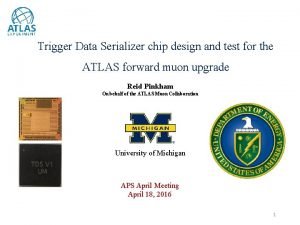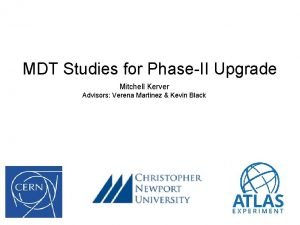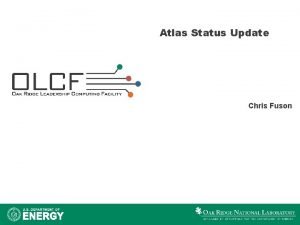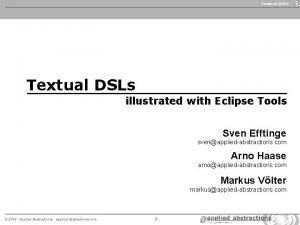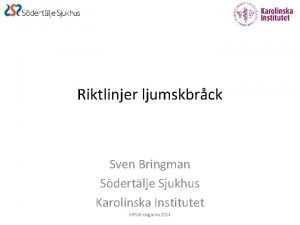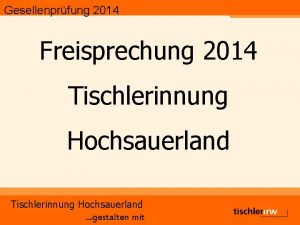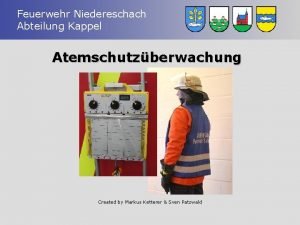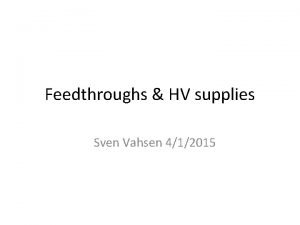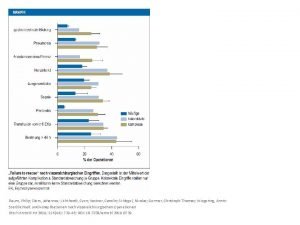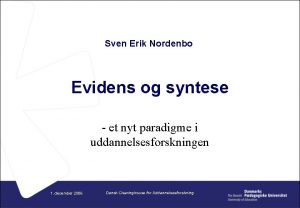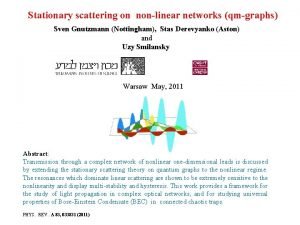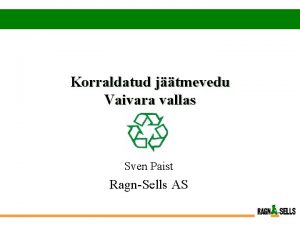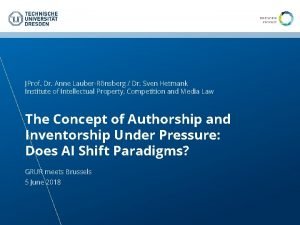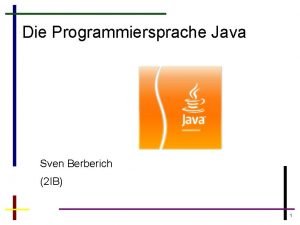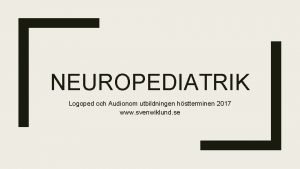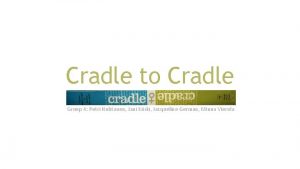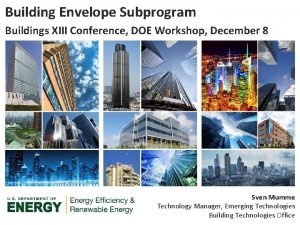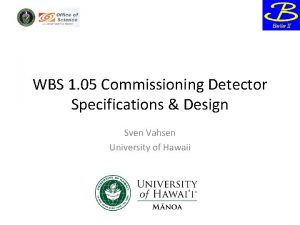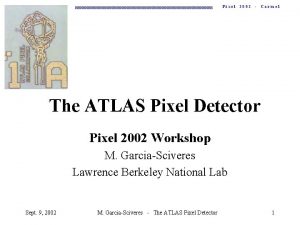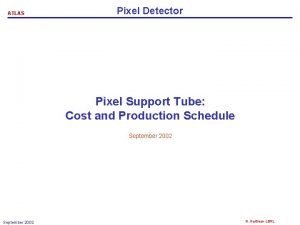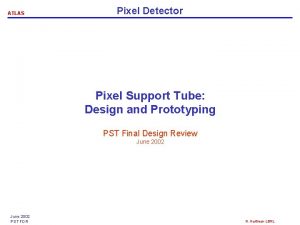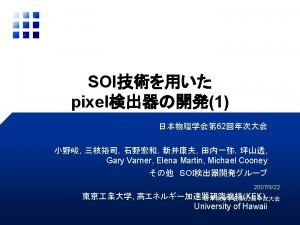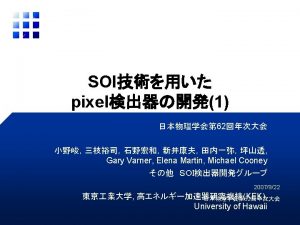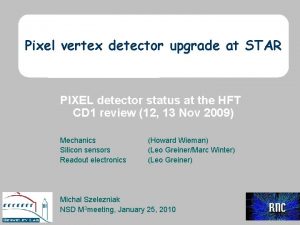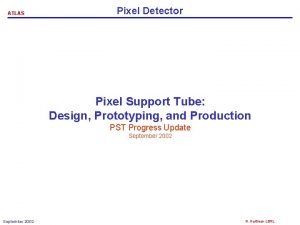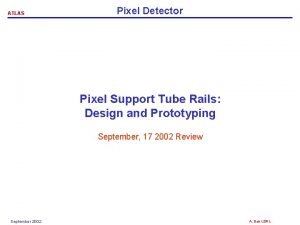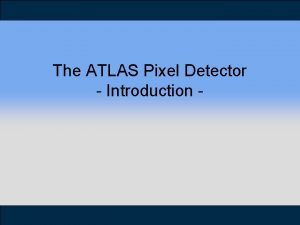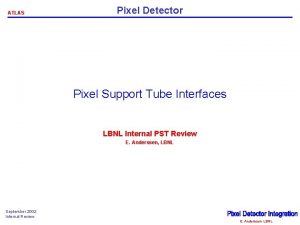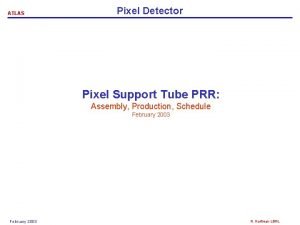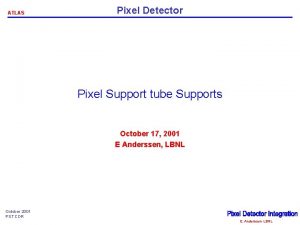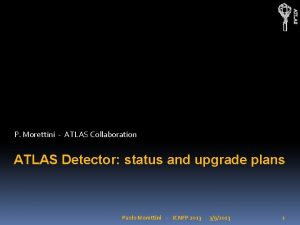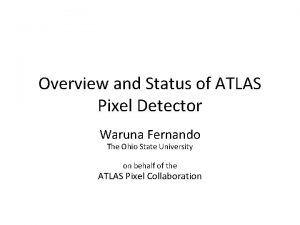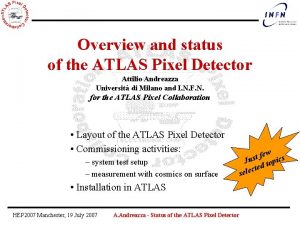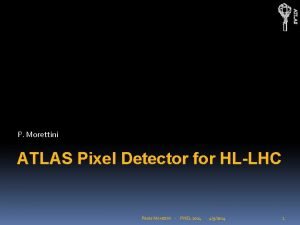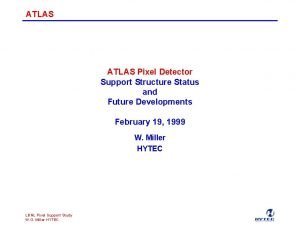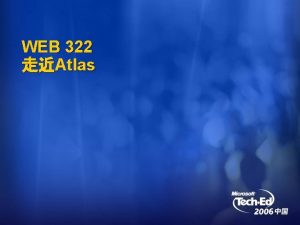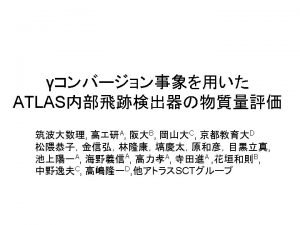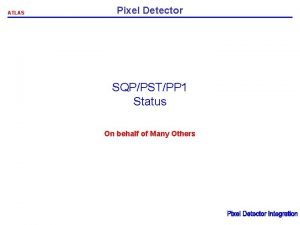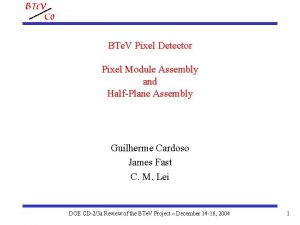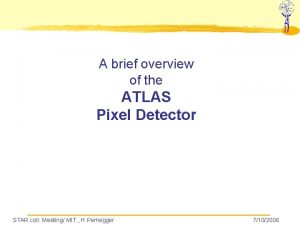the ATLAS Pixel Detector Overview and Status Sven































- Slides: 31

the ATLAS Pixel Detector: Overview and Status Sven Vahsen, LBNL for the ATLAS Pixel collaboration DPF 2006 Meeting, Honolulu, Hawaii October 30, 2006 Honolulu, October 30 2006 Sven Vahsen, LBNL

Near Geneva, Switzerland, underground… • Large Hadron Collider (LHC) under construction near Geneva, Switzerland • Eventually • 7 -Te. V proton-on-proton • Beam crossings every 25 ns • L = 1034 cm-2 s-1 (ATLAS / CMS) 2006 Honolulu, October 30 2006 2007 2008 First beams and collisions (0. 9 Te. V) Full physics run (14 Te. V) Sven Vahsen, LBNL 2

ATLAS! • • Length Width Height Weight Honolulu, October 30 2006 * ATLAS = A Toroidal LHC Apparatus ATLAS: multi-purpose particle detector Optimized for study of Electroweak symmetry breaking and search for physics beyond SM at the LHC Under construction around one of the LHC interaction points To be completed in time for first beam in 2007 = 55 m = 32 m = 35 m = 7000 T Sven Vahsen, LBNL 3

From ATLAS to Pixels: Mechanical Overview ATLAS Pixel Detector – Innermost tracking detector, surrounding beam pipe physicist 6 cm Pixel 1. 3 m Detection of charged particles takes place in 1744 identical ATLAS Pixel Modules x 46080 50 x 400 μm 1744 modules x 46080 pixels = 80 million channels! Honolulu, October 30 2006 Sven Vahsen, LBNL 4

Pixel Project Overview • Pixel Detector is last subdetector to be installed in ATLAS April 2007 as the 7 m “Pixel Package”, which includes — Service panels (connections for electrical, optical, cooling) — Be beam pipe • Remaining work at CERN — Final stages of integration — Connection of service panels — Testing • Remaining slides — Overview of the pixel detector and how it works — Status of the project Trial insertion of pixel frame into support tube Honolulu, October 30 2006 Sven Vahsen, LBNL 5

The LHC Tracking Challenge • ATLAS tracking : three sub-detectors from r = 5 cm - 1. 2 m, inside 2 T magnetic field. • Pixel Detector innermost highest granularity and radiation tolerance With pile-up at (36 sp) H’bb interaction design luminosity (3 sp) (4 sp) Only tracks with PT>1 Gev, 0<h<0. 7 shown Only Si hits with 0<h<0. 7 shown Only TRT hits with Z>0 shown Pixel Detector design constraints from LHC timing / event-environment physics, ATLAS design • Tracking in high multiplicity environment high granularity • Good impact parameter resolution high granularity + low mass • Distinguishing hits 25 ns apart fast preamp rise time • 3. 2 μs trigger latency (LVL 2) on detector buffering of hits • High radiation dose low temp. , high radiation tolerance Honolulu, October 30 2006 Sven Vahsen, LBNL 6

The Pixel Detector Solution – Modules overlap on the support structure to provide hermetic coverage: 3 space points for |η|<2. 5 for collisions up to 11 cm from nominal IP – 3 barrel layers at r = 5, 9, 12 cm – 2 endcaps with 3 layers 1. 3 m – Will be first large-scale active pixel device in operation – i. e. ~ each pixel read out by dedicated preamp: 80 million channels – Approx. 10 k. W operating power in active volume, at 2 V – Detector will operate at -7°C – Cooling integrated into local support structure via thinned aluminum tubes, C 3 F 8 evaporation – Total mass is 10% X 0 normal to beam Honolulu, October 30 2006 Sven Vahsen, LBNL 7

The ATLAS Pixel Module • • • Kapton flex circuit: routes signals between FE and MCC. Routes LV (2 V, 1. 6 V) to chips and HV (150600 V) to sensor Sensor: where charged particles traversing detector liberate charge: 2 cm x 6 cm x 250 μm n bulk silicon rectangle, with 47, 268 n+ pixels 16 Front End (FE) chips: preamp channels, each connected to sensor pixels via bump bonding Solder bumps 50 μm • • • Hits buffered for up to 3. 2 μs (LVL 2 latency) in “End Of Column” buffers on FE-chip Upon LVL 2 trigger, Module Control Chip (MCC) combines hits from FE chips into event Data is read out electrically from module via 1 m “Type 0” cable @ up to 160 Mb/s Honolulu, October 30 2006 ~ 2 x 6 cm • Data is converted between electrical and optical at far end of Type 0 cable Sven Vahsen, LBNL 8

The Pixel Detector Module – Sensor wafer 50 μm pitch – – – Solder bumps 16 FE chips Bump-bonded onto sensor Electronics Design Work started ~ 10 years ago Final version (Dec 2003) of FE chip is “FE-I 3”: – 0. 25 μm CMOS process, IBM, 3 M transistors! Honolulu, October 30 2006 Sven Vahsen, LBNL 9

Single Pixel: Detection of a Charged Particle • apply (150 -600 V) reverse bias voltage • Free charge carriers (electrons & holes) are removed: silicon “depleted” • no incoming particles only leakage current < 1 n. A / pixel • A passing charged particle at normal incidence liberated on average 22, 000 electron-hole pairs per 300μm (~4 f. C) • charge swept towards bumps and into FE preamp by electric field, where it is converted to voltage pulse • charge typically shared by a few (1 -3 pixels) Honolulu, October 30 2006 Sven Vahsen, LBNL 10

The Pixel Preamp (single pixel) threshold Sensor / bump Q=CV • • In FE chip, charge-integrating amplifier converts • charge pulse from sensor into voltage pulse Ouput voltage above threshold digital hit stored in EOC buffer • Time over threshold (TOT) proportional to charge Information from hit ultimately preserved — Bunch crossing ID (BCID) — Time over threshold charge — Pixel Geographical address Honolulu, October 30 2006 Digital controls for each pixel’s preamp threshold and more Time over threshold (TOT) can improve position resolution in case of charge sharing: charge-weight each pixel Sven Vahsen, LBNL 11

Module Performance • Many test beam measurements: efficiency, timing properties, charge collection, spatial resolution • Results incorporated into ATLAS simulation/digitization • High efficiency and good timing characteristics even after irradiation Unirradiated 60 MRad, ~1015 n/cm 2 Single pion test beam efficiency vs. trigger timing (10 ns/DIV) Honolulu, October 30 2006 Sven Vahsen, LBNL 12

Pixel Performance Tracking Performance • Pixel single-point resolution in r/phi — TDR: want < 13 μm — Test beam: • Determines resolution of transverse impact parameter, d 0 (for b-tagging) — three tracking algorithms — “new. Tracking” takes full advantage TOT measurement to • 7. 5 μm before irradiation (at improve resolution in case of incidence angle 10 o) charge-sharing • 9. 7 μm after irradiation (at incidence angle 15 o) σ(d 0) in μm —Simulation of single-muons, p. T=200 Ge. V/c (low multiple scattering) —plot σ(d 0 generated – d 0 reconstructed) Honolulu, October 30 2006 Sven Vahsen, LBNL 13

Module Production & Testing: Done! 1744 • Two commercial bump bonding vendors, six academic laboratories all running in parallel. • ~ 12 FTE technicians and 15 FTE physicists & students for 2 years. • Each individual pixel tested and characterized at intended operating temperature, -7°C • Preamp properties with internal injection circuit • Bump connectivity with 60 ke. V X-ray source • Built more modules than needed, ranked them by quality, discarded the worst Honolulu, October 30 2006 Sven Vahsen, LBNL 14

Local supports: Staves and Sectors Highest-quality modules glued onto carbon support structures, which incorporate cooling tubes “Type 0” cable “Disk Sectors” in endcap (double sided) Honolulu, October 30 2006 Al cooling tube “Staves” in barrel “pigtail” Sven Vahsen, LBNL 15

Integration: Endcaps Done! • Sector Disk Endcap • Both endcaps completed in U. S. and shipped to CERN x 8 x 3 Three completed Pixel disks (one end-cap) with 6. 6 M channels Honolulu, October 30 2006 Sven Vahsen, LBNL 16

Pixel Endcap C: Traveling in style! SFO Newark Geneva, Business class! Geneva CERN: Volvo, back seat, lots of padding Honolulu, October 30 2006 Sven Vahsen, LBNL 17

10 -3 DEAD PIXELS # MODULES • Strict QC at all levels of integration — Bumps disconnecting when gluing modules on sector? — Increase in noise? — Placement precision? — Thermal performance? # MODULES Endcap quality PIXEL NOISE (e-) • Everything within spec! — Dead channels • Endcap C < ~0. 2% • Endcap A slightly worse 3 modules need work — No noise increase — Placement precision of modules on sectors: 2. 6 μm w. r. t. to target position in sector place Honolulu, October 30 2006 Sven Vahsen, LBNL 18

Integration: Barrels • 13 modules “loaded” onto each stave and tested at European institutes • Loaded staves then shipped to CERN for further integration, as shown here • Dedicated tooling developed to do carry out each integration stage safely Two staves bi-stave with cooling U-Link… Loaded half-shells clamped together Layer 2 …inserted into half-shells… Layer 1 B Layer Honolulu, October 30 2006 Sven Vahsen, LBNL 19

Layer 2 completed on Sept 10 Pixel Layer 2 – Half shell Pixel Layer 2, after clamping Pixel Layer 2, in Global Support Pixel Layer 2, after clamping Layer 2 used lowest-quality accepted barrel modules. Still only < 0. 3% bad channels Honolulu, October 30 2006 Sven Vahsen, LBNL 20

Integration of Remaining Barrel Layers • Layer 1: finished last week (after pictures) Pixel Layer 1, 1 st half-shell completed Pixel Layer 1, 2 nd half-shell. One bi-stave under test • Expect to finish b-layer in ~ 3 weeks • Integrate all barrels and end-caps by the end of 2006 Honolulu, October 30 2006 Sven Vahsen, LBNL 21

System Test and Cosmics • Final integration takes place in December, but endcaps already complete One endcap has been highjacked for an 8% (6. 6 M of 80 M channels) system test • Will exercise many production parts of system not mentioned in this talk — Services — DAQ — Control and interlock system • Use scintillators to trigger on vertical cosmics

The End Game • Jan-Feb 2007 devoted to Service Panel integration • If time left before installation (currently we have one month contingency) it could be used for cold test of whole pixel package • Insertion of pixel package into ATLAS in April 2007, followed by months of connecting, cabling, and testing • And then, hopefully, first LHC beam! Honolulu, October 30 2006 Sven Vahsen, LBNL 23

Conclusion • Following nearly a decade of R&D, and years of production, Atlas Pixel Detector now in the final stages of integration —Both Endcaps complete and at CERN —Barrel L 2, L 1 complete, b-layer in a few weeks → 3 Layer Pixel Detector on schedule for installation in ATLAS in April 07!

BACKUP SLIDES Honolulu, October 30 2006 Sven Vahsen, LBNL

Problems Overcome • cooling pipe corrosion • breaking cables

Tuning A Module • A module has 46 080 channels in 2 x 6 cm area, typically > 99. 8% fully functional • Process variation across FE chips, preamps differ need “tuning” to make response of all pixels uniform • Each preamp has digitial “knobs” for tuning the preamp behavior, . e. g. • Tuning = find the settings for each pixel that give uniform response across module Adjust threshold untuned module of each pixel • In lab tests to date, typically tune to threshold of 4000 electrons • Well above typical noise of ~170 electrons • Modules work great, no stability issues! Honolulu, October 30 2006 Sven Vahsen, LBNL 27

Actual ATLAS Pixel Sensor Bumps connect to implants P-spray doping to isolate individual pixels Heavily n-doped pixel implants (doping too heavy to deplete) Diode junction Lightly n-doped bulk Heavily p-doped back side contact • • Guard rings A diode junction forms wherever p-doped and n-doped regions touch. Depletion always begins at the diode junction as reverse external voltage is applied. Hadron irradiation introduced p-type defects. Eventually this will cause the bulk to “type invert” and become p-type. At this point the diode junction shifts to the top. This was chosen on purpose because it allows to operate without fully depleting the bulk. • Leakage current increases drastically with irradiation! Honolulu, October 30 2006 Sven Vahsen, LBNL 28

Pixel Chip Front End Input from Pixel sensor (bump goes here) Honolulu, October 30 2006 preamp Sven Vahsen, LBNL comparator 29

The MOS transistor schematic of the FE-I 3 charge amplifier • Above is just one pixel! • 2880 pixels / readout chip ~3 M (MOS) transistors / chip FE -I 3). Honolulu, October 30 2006 Sven Vahsen, LBNL 30

Front End Features • Programmable threshold = Global Threshold + Pixel Threshold Can easily change threshold for whole chip • Calibration charge injection Input from detector V 1 V 2 Can fine tune each pixel to compensate for response differences (Tuning) switch Injection capacitor (must be small) Good old charge amplifier • Ability to measure leakage current • Time over Threshold (TOT) charge measurement – How long the red curve says above threshold depends on the size of the input charge Honolulu, October 30 2006 Sven Vahsen, LBNL 31
 Txp100
Txp100 Atlas detector
Atlas detector Atlas status 2014
Atlas status 2014 Sven erik gisvold
Sven erik gisvold Sven efftinge
Sven efftinge Sven kepes
Sven kepes Parietene
Parietene Fhs holztechnik arnsberg
Fhs holztechnik arnsberg Sven jaschan
Sven jaschan Sven jaschan
Sven jaschan Sven patzwald
Sven patzwald Sven jani
Sven jani Antimattet
Antimattet Sven kastner
Sven kastner Sven laur
Sven laur Juguler ven
Juguler ven Sven erik nordenbo
Sven erik nordenbo Sven nyholm
Sven nyholm Sven gnutzmann
Sven gnutzmann Sven paist
Sven paist Sven hetmank
Sven hetmank Sven van laere
Sven van laere Sven berberich
Sven berberich Sven vorstius bayer
Sven vorstius bayer Sven jani
Sven jani Sven hauff
Sven hauff Neuropediatrik
Neuropediatrik Sven tiffe
Sven tiffe Sven jani
Sven jani Sven mumme
Sven mumme Sven reiche
Sven reiche Sven vahsen
Sven vahsen
